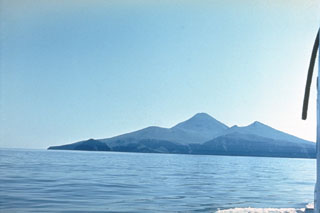Report on Chirpoi (Russia) — 4 June-10 June 2014
Smithsonian Institution / US Geological Survey
Weekly Volcanic Activity Report, 4 June-10 June 2014
Managing Editor: Sally Sennert.
Please cite this report as:
Global Volcanism Program, 2014. Report on Chirpoi (Russia) (Sennert, S, ed.). Weekly Volcanic Activity Report, 4 June-10 June 2014. Smithsonian Institution and US Geological Survey.
Chirpoi
Russia
46.532°N, 150.871°E; summit elev. 742 m
All times are local (unless otherwise noted)
In a 5 June report, SVERT summarized activity at Snow, a volcano of Chirpoi, over the previous two years: an effusive eruption started on 10 November 2012, producing steam-and-gas emissions and thermal anomalies thorough April 2013; the volcano was quiet; steam-and-gas emissions and thermal anomalies were again detected starting on 12 July 2013, suggesting a new period of lava effusion. Weak thermal anomalies during 2-4 June implied cooling lava flows. The Aviation Color Code was lowered to Green.
Geological Summary. Chirpoi, a small island lying between the larger islands of Simushir and Urup, contains a half dozen volcanic edifices constructed within an 8-9 km wide, partially submerged caldera. The southern rim of the caldera is exposed on nearby Brat Chirpoev Island. The symmetrical Cherny volcano, which forms the central cone of the island, erupted twice during the 18th and 19th centuries. The youngest volcano, Snow, originated between 1770 and 1810. It is composed almost entirely of lava flows, many of which have reached the sea on the southern coast. No recorded eruptions are known from Brat Chirpoev, but its youthful morphology suggests recent Strombolian activity.

